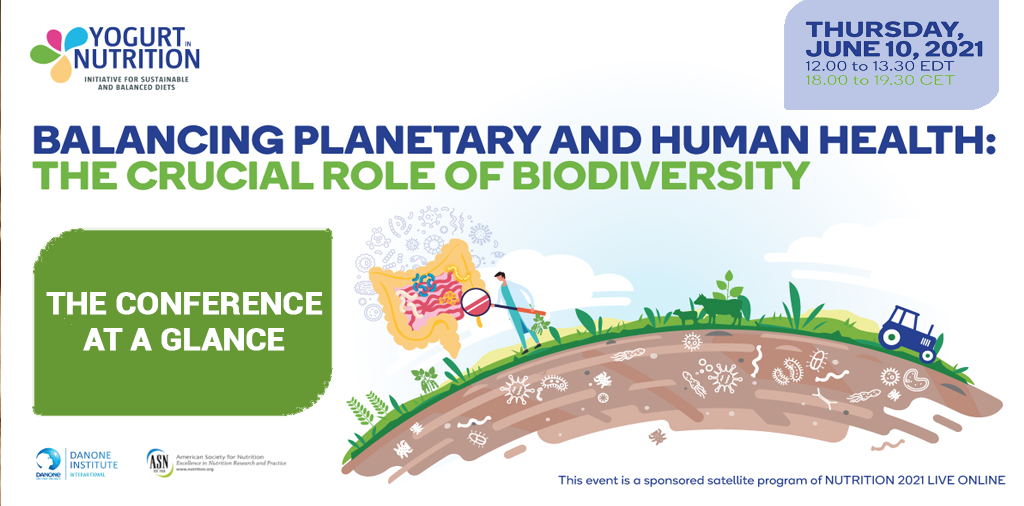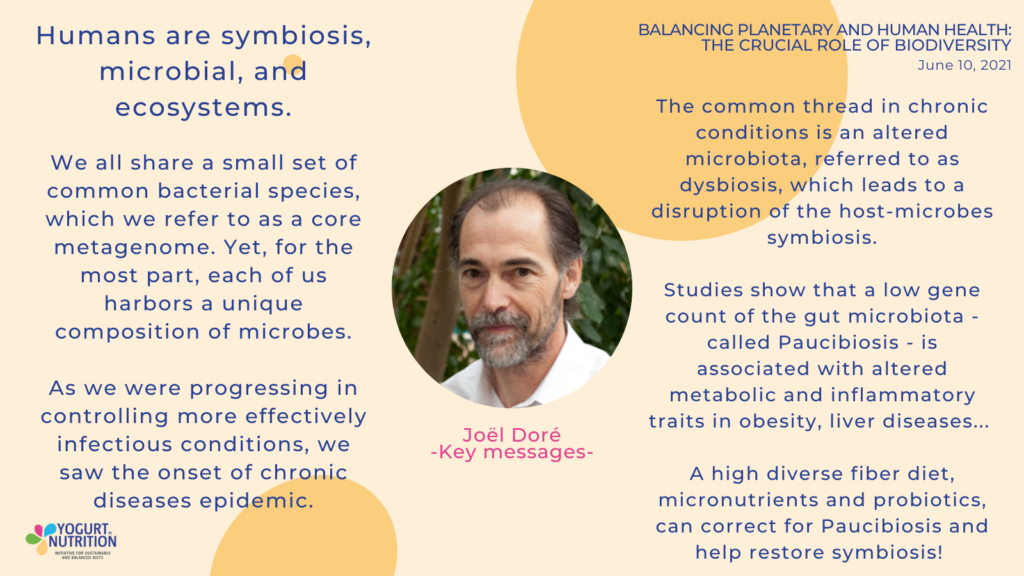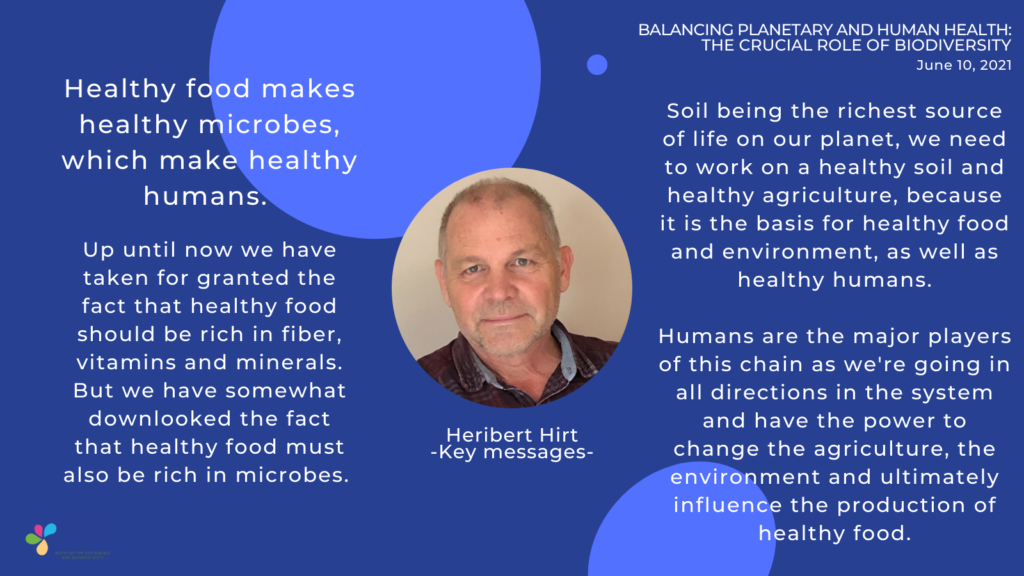As satellite symposium during the ASN Nutrition Live 2021, the Yogurt in Nutrition Initiative gathered scientists worldwide through an online event focused on ”Balancing Planetary and human health: the crucial role of biodiversity”.
The overall goal of this 9th summit is to highlight the crucial role of biodiversity and microbiome, concerning our own health through the gut microbiota, or the one of the planet (soil microbiome diversity). With the enthusiastic co-animation by Sharon Donovan, PhD, RD and Emeran Mayer, MD, three experts share their knowledge on the wide topic of biodiversity and interconnection between planet, people and health: Fabrice DeClerk, Heribert Hirt and Joël Doré.
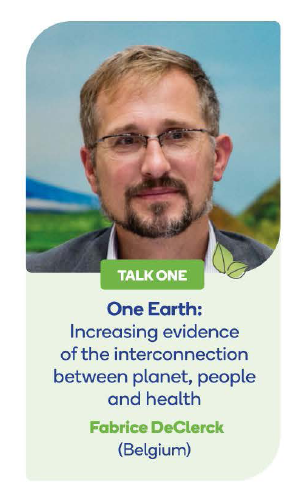 One Earth: Increasing evidence of the interconnection between Planet, People & Health
One Earth: Increasing evidence of the interconnection between Planet, People & Health
Fabrice DeClerck (Senior Scientist, Agricultural Biodiversity and Ecosystem Services, Belgium and France) begins the conference by emphasing on the key interconnections between the planetary and human health and a need to a global ”one-earth approach”.
Fabrice DeClerck studies “ecology” and it is with this definition that he introduces his presentation. Ecology is etimologically the ”study of the House”. And there are here two houses: the human and the planet earth. On this planet, human has a great power and human activities have major impacts.
Among those activities, food is one of the most intimate relationship we may have with nature and with health: what food we eat, how and where we produce it. Yet these relationships are broken.
Food has become a driver of poor health and leading causes of premature mortality globally. Nearly half of the world’s population struggle with either gaining access to enough food, or the right foods. Overconsumption has become both a health problem, and an environmental problem, as food is also a large source of environmental degradation driving planetary boundaries to critical tipping points.
We are beginning to understand the consequences of foods transgression on climate, land, water, and nutrient boundaries. We are now realizing that the diversity of food we put on our plate is decreasing, getting more homogenized around the world and in parallel, global biodiversity is declining.
If the food we produce and eat has an impact on biodiversity, it affects also directly two ecosystems, which are part of this biodiversity; the soil microbiome and human gut microbiota.
The two main questions regarding the maintain of those microbiomes biodiversity and richness are what are the sources of those microbiomes and how we maintain this microbiome (antibiotics or diets on human microbiome; soil treatments, massive extension culture or culture rotations for soil microbiomes).
A one-earth approach fundamentally recognizes the biological nature of life on earth, and seeks to create the practices that work with nature, rather than against it. By doing so, we will be able to achieve sustainability targets, and build back better. As we look to 2030, there is a huge goal to bend the curve and again preserve and enrich the biodiversity. Regarding the microbiomes, the question will be: Can we be better to maintain microbiome diversity and move from “anti-biotic to pro-biotics”.
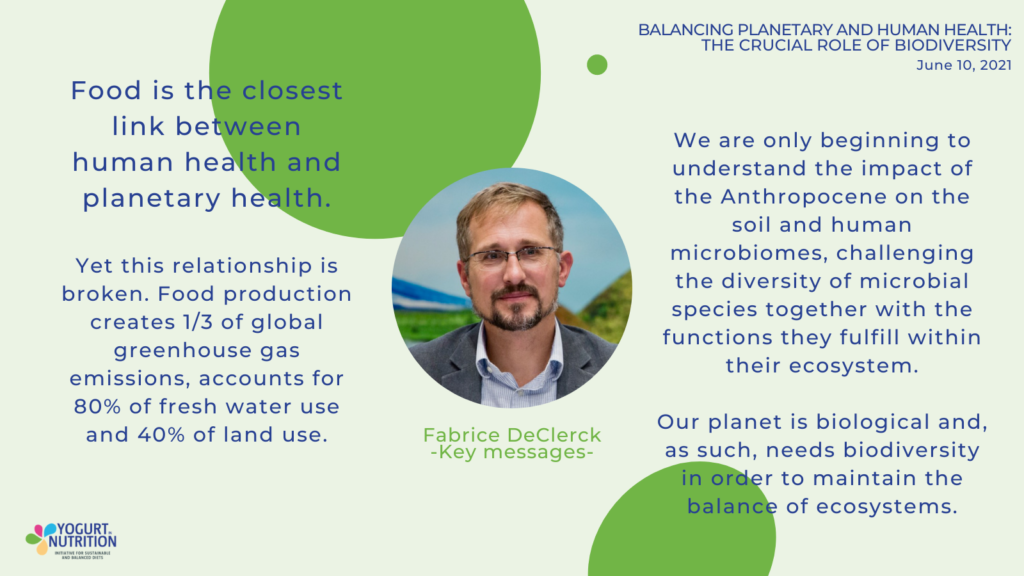
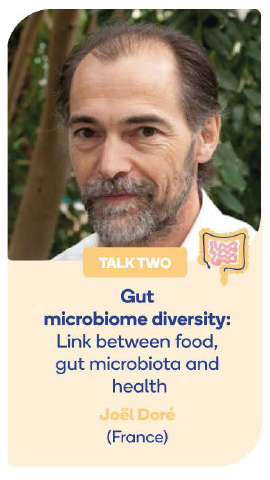 Gut microbiome diversity: Link between food, gut microbiota and health
Gut microbiome diversity: Link between food, gut microbiota and health
After this journey through biodiversity and microbes ecosystems, Joël Doré (Research Director, INRAE, France) makes a zoom on the gut microbiota and links between food, gut microbiota and health.
There is a symbiotic relationship between the human and its microbiota that starts at birth. Maturation of our immunity is strongly associated with our microbiota. Our gut microbiota count more than 5 billions cells, as many as our human cells.
As the studies on microbiota progress, we now know that we all share a small set of common bacterial species and harbor a large unique set of microbes. We differ by our gut ecology and gene count. However, it seems that this gut microbiota is evolving. Through history we have seen that as much as we were better controlling medicine, epidemics and hygiene, there were an increase of chronic diseases and autoimmune chronic diseases.
The common thread in chronic conditions are mostly related to altered microbiota and dysbiosis, a disruption of the host-microbes symbiosis. Studies on the microbiome genes show that a low diversity on gut microbiota (low gene count also called paucibiosis) is associated with altered metabolic and inflammatory traits in obesity, liver diseases… However, the good news is that a high diverse fiber diet can correct that paucibiosis in overweight and obesity. To go further, a mix of micronutrients, probiotics, fibers can act to restore symbiosis and we can act through food to restore symbiosis.
”Humans are symbiosis, microbial and ecosystems.– Joël Doré”
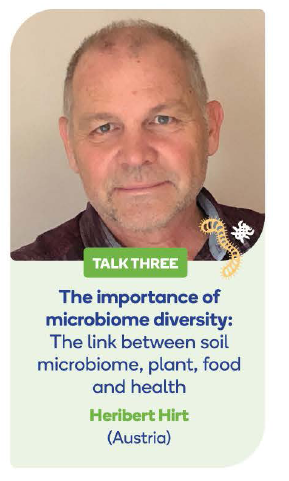 Soil microbiome diversity: The link between soil microbiome, plant, food and health
Soil microbiome diversity: The link between soil microbiome, plant, food and health
After this focus on human microbiota, Heribert Hirt (Director of the INRA/CNRS Plant Genomics Institute in Paris, France and of the Center for Desert Agriculture at KAUST, Thuwal, Saudi Arabia) goes further on the innovative topic of soil microbiome.
Recent findings show that beneficial microbes are essential for establishing and maintaining a healthy gut microbiome. Many of these beneficial microbes in the human gut can be obtained from eating healthy foods, but most current healthy food concepts still lack the aspect of healthy microbes.
Healthy food is mainly described has rich in fruits, vegetables, fibers. However, healthy food must also be rich in microbes and there, fruits and vegetables are an interesting source of microbes, as the soil they grow in, is full of them. 1 gram of soil harbors 10 trillion of microbial cells and plants adopt microbes from their soil, in which they are borne and thrive.
It is hardly known that many of these beneficial microbes in healthy food are also essential for protecting plants from bacterial, fungal and viral diseases and that the large use of pesticides and herbicides in agriculture challenges the life of gut, plant and soil microbes.
Pesticides affect gut microbiota as well as soil microbiota. It is now clear that pesticides have eradicated bacterial soil microbiota species and therefore favorite other species and change the balance of the soil microbiota. Logically, on treated vegetables and fruits, you may find pesticide residues but also a poorer microbiome.
The key is therefore to move forward a future agriculture where we can replace most of the conventional pesticides. It would lead indirectly to a healthier gut microbiome.
The take home messages:
- healthy soil= rich source of microbes, healthy plants
- healthy plants = healthy food
- healthy food = rich source of healthy microbes = healthy humans
According to Heribert Hirt, healthy food forms the basis of human health and we must aim to make healthy food available to every human on this planet.
“It is hardly known that many of these beneficial microbes in healthy food are also essential for protecting plants from bacterial, fungal and viral diseases – Heribert Hirt”
As Emeran Mayer concludes: We heard talks about the “one earth” concept, gut microbiome diversity, soil microbiome diversity. The common part of those three talks are the interactions, the biodiversity and the unique role of microbes.
It is important to realize that:
- the microbiomes have to be managed as global complex systems, not as individual species (where the microbes interact with the body as well as the environment and there are no linear relationship between the microbes in our body and us).
- there are similarities between soil and human microbiomes as well as plant and human health.
If you put this all together, the close interconnection between planetary health, health of the soil and human health call for a close attention to the microbiome.
Stay tuned…. in a few days, the replay of the symposium will be available online.

